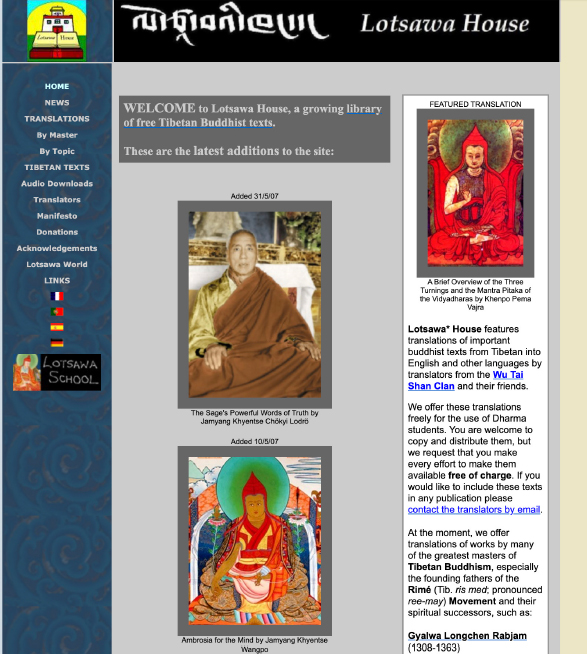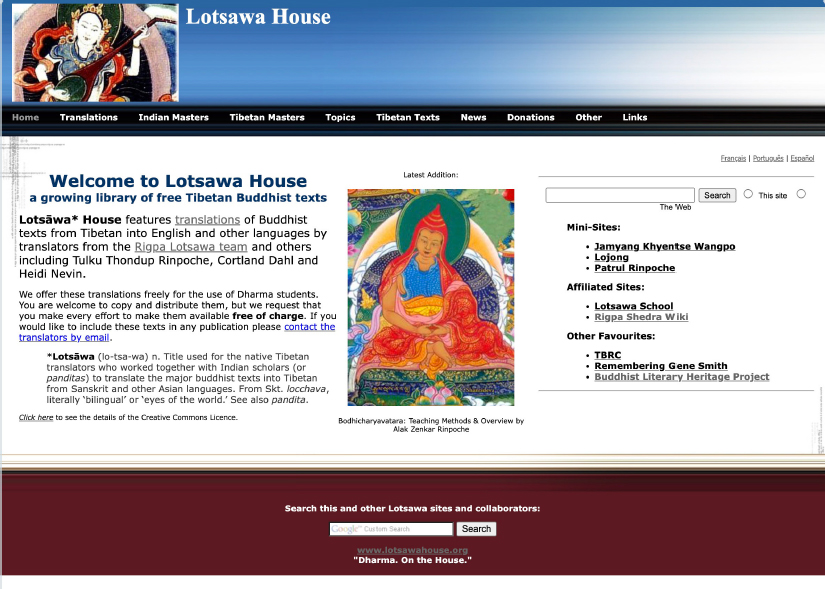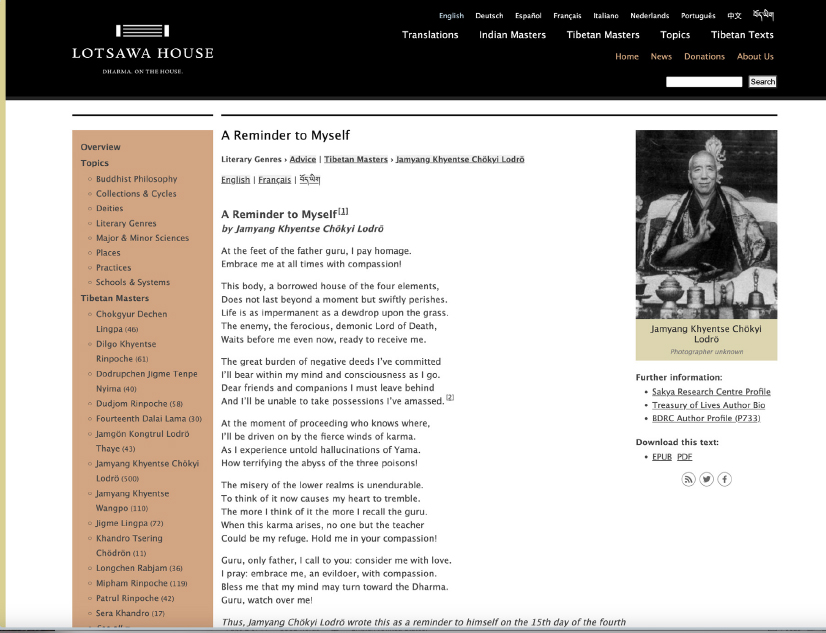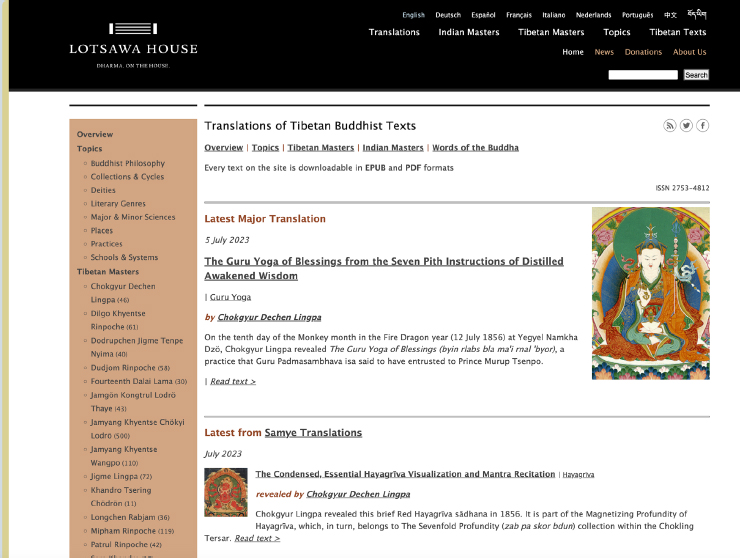On the House: Twenty Years of Online Tibetan Translation
Adam S. Pearcey
The Lotsawa House name came about accidentally. It was originally intended for a website that would record the experiences of a group of trainee translators living and studying together in a house in Kathmandu. The word lotsāwa was intended ironically; we weren’t making any grand claims. The proposed site would record the students’ progress, highlight their challenges and achievements, and include photos and occasional interviews. Soon after registering the domain, however, it became clear that a more useful website would be one that hosted translations, including, eventually, some by the trainees themselves. I had a few unpublished drafts on my computer, too short for a book project but ideal for online publication. This, then, is how the House began: the translators moved out and the translations moved in.
The year was 2004, and the possibilities of online publishing were just becoming apparent. Connection speeds had improved, and downloads were replacing CDs as the most convenient means of sharing large files. Some of the sites that we rely on today—not least, of course, the Tibetan Buddhist Resource Center, as it was then (Buddhist Digital Resource Center now)—were beginning to take advantage of these developments and become indispensable as tools of research. Making texts available to a large audience, freely and instantaneously, was feasible, and there were models to emulate and learn from. One pioneer and early inspiration was Andreas Kretschmar’s site (www.kunpal.com) through which he shared chapters of the Bodhicaryāvatāra commentary by Khenpo Kunsang Palden (Mkhan po Kun bzang dpal ldan, 1862–1943); another important reference was the Asian Classics Input Project.
Things moved quickly at first. As soon as we had a basic—make that very basic—design, including a garish logo, and a few texts, I sent the link to some trusted advisors requesting feedback. E. Gene Smith was among the first to reply and offer words of encouragement. A line from his message—“May [the website] flourish and the number of translations grow vast!”—remains our guiding aspiration to this day. The ongoing quest to fulfil this goal has helped shape our more immediate policies and priorities: to focus on shorter works by a range of authors from different traditions, include multiple languages, collaborate with other translators and groups, and emphasize accessibility.
The first texts to appear were short commentaries and essays by Jamyang Khyentsé Wangpo (’Jam dbyangs Mkhyen brtse’i dbang po, 1820–1892), Patrul Rinpoché (Dpal sprul Rin po che, 1808–1887), and Khenpo Tsöndrü (Mkhan po Brtson ’grus, 1920–1979). Songs and advice from Nyala Pema Düdul (Nyag bla Padma bdud ’dul, 1816–1872) and Mipham Rinpoché (Mi pham Rin po che, 1846–1912) soon followed. We added French translations in 2005, and by 2007 there were Spanish, Portuguese, and German sections too, as well as, wherever possible, the original Tibetan. Since then, we have also added Italian, Dutch, and Chinese.

We identified Creative Commons as the most appropriate form of license and made the idea of sharing (with attribution) an essential part of our ethos. It was not long before other translators noticed the site and offered their own contributions—Heidi Nevin and Cortland Dahl being among the first to do so. We were also fortunate that Tulku Thondup Rinpoché permitted us to share a beautiful text on flower offering by Dodrupchen Jigmé Tenpai Nyima (Rdo grub chen ’Jigs med bstan pa’i nyi ma, 1865–1926). In time, lamas themselves began to suggest texts for inclusion. Alak Zenkar Rinpoché (b. 1943) provided several and kindly bestowed the relevant transmissions.
Electronic publishing has its advantages, the most obvious, besides its immediacy, being the ability to amend and update texts. Many corrections have come from translators working on non-English versions, but helpful readers also notify us of errors from time to time.[1]
From the handful of texts with which Lotsawa House began in 2004 the site has grown, through the combined efforts of more than a hundred translators and editors, to accommodate more than 2500 translations in eight languages—the writings of approximately 300 authors on 200 different topics. We are now home to two major projects, one to translate the collected writings of Jamyang Khyentsé Chökyi Lodrö (’Jam dbyangs mkhyen brtse Chos kyi blo gros, 1893–1959) and another to translate the root volumes of the Longchen Nyingthik (klong chen snying thig), or Heart-Essence of the Vast Expanse. The latter focuses primarily on the revelations of Jigmé Lingpa (’Jigs med gling pa, 1730–1798) but so far includes the writings of at least fifteen other authors.

As the site grows, it can be difficult to maintain a consistency of tone. One of the most important tasks for an editor is to help translators find what Chana and Ariel Bloch refer to as the proper register, which is “neither too formal and stylized nor too breezy and colloquial—language that is fresh and urgent and passionate, and at the same time dignified.”[2] We may not always achieve this, but it helps to have a clear objective. Philosophical texts and commentaries can be precise yet clear; liturgies can be moving even without the use of archaisms or what Orwell called “pretentious diction”— phrases like endowed with, engage in, or emanate forth. Still, consistency is not quite the same as uniformity. The editor’s role can be educational and persuasive, helping translators become aware of their own choices, so that when they split an infinitive, for instance, they do so deliberately. And when they invite readers to enter a path rather than set out on one, or go for refuge rather than take it, they know which is the more idiomatic. Translators must pay attention to their own style, but they must also reflect the idiosyncratic style of their sources, even as this varies according to genre. Authors may adopt the most ornate poetry in one text, for example when praising their teachers, and then restrict themselves to simpler forms in another, such as when advising their disciples. Ideally, this contrast will be apparent even in translation.
Texts produced during the initial phase of Tibetan Buddhism’s transmission to the English-speaking world tended to focus more on communicating ideas than on reproducing subtleties of form and style. To give an example from Lotsawa House, consider the following four-line aspiration for the flourishing of the Nyingma tradition composed by Düdjom Rinpoché Jikdral Yeshé Dorjé (Bdud ’joms ’Jigs bral ye shes rdo rje, 1904–1987):[3]
མཁན་སློབ་ཆོས་གསུ༷མ་རིང་ལུགས་ཆེ། །
འཛམ་གླིང་ས་གསུ༷མ་ཁྱབ་པར་འཕེལ། །
འགྲོ་རྒྱུད་མཆོག་གསུ༷མ་སྣང་བ་དང༌ ། །
མི་འབྲལ་དུས་གསུ༷མ་དགེ་ལེགས་ཤོག །
An early translation reads as follows:
May the living tradition of Guru Padmasambhava, Abbot Śāntarakṣita and the Dharma King Tri Songdetsen
Spread throughout the world in all directions!
May the Buddha, Dharma and Saṅgha be present in the minds of all,
Inseparably, at all times, bringing peace, happiness and well-being!
This is not inaccurate, but it is explanatory. The translator is clearly anxious that readers might not identify the trio mkhan slob chos gsum unless the names are spelled out in full and that they might also fail to recognize what mchog gsum represents. There is no attempt to reproduce the most prominent stylistic feature of the source text, that each line has the word for “three” (gsum) as its fourth syllable. Indeed, the word “three” does not appear at all. This is what we could call a first-generation translation: it prioritizes the meaning of the original, conveying it in a way that is comprehensible even to a readership largely unfamiliar with key themes and expressions. A second-generation translation might look more like this:
May the great tradition of the three—abbot, master, and dharma-king—
Spread throughout the three regions of this world.
And may the Three Supreme Ones be present in the minds of all,
Inseparably, throughout the three times, bringing virtue and excellence!
This version provides less explanation but more closely matches the style of the original. There is nothing to prevent a first-generation translator producing such a rendering, of course, but to do so would entail a greater risk of confusion. As cultural familiarity and understanding increase in the target audience, translators can afford to be less expository and more faithful to stylistic devices.
The same applies to technical terminology. As translators and students become more familiar with key Buddhist concepts there is greater consensus on how to render them in English—or whether to leave terms untranslated. Consider the following passage from a fifty-year-old translation of a text on analytical meditation (dpyad sgom) composed by Jamgön Mipham (’Jam mgon Mi pham, 1846–1912):
འདི་ལྟར་འཕགས་པའི་ལུང་བཞིན་དུ། །
ཞི་ལྷག་ལམ་གྱི་སྔོན་འགྲོ་རུ། །
སེམས་ཀྱི་སྤྱོད་པ་རྣམ་སྦྱོང་བའི། །
ཐེག་གསུམ་ལམ་གྱི་གལ་གནད་བཤད། །
In the teaching of the Noble Tradition
This purification by mindfulness,
Preparation of calm and clarity,
Has crucial stress in the three careers.[4]
A more recent translation of the same verse on Lotsawa House reads:
Based on the statements of noble masters, I have here explained
The important points of the paths of the three vehicles,
Which provide a thorough purification of mental activity,
As a preliminary to the paths of śamatha and vipaśyanā.[5]
This version employs the broadly accepted translation of “vehicle(s)” for yāna (Tib. theg pa) and the standard “preliminary” for sngon ’gro. “Mindfulness” is so firmly associated with dran pa/smṛti that we prefer “mental activity” for sems kyi spyod pa. While the 1973 translation opts for “calm” and “clarity”, our version favors the Sanskrit śamatha and vipaśyanā, which are arguably more recognizable than their various English counterparts, at least for now. As the usage of terms continues to evolve, updates will remain a regular requirement.
Online publishing also makes it easier to deal with the frequent borrowing that characterizes Tibetan Buddhist literature. To give just one example from the site, when Khenpo Ngawang Pelzang (Mkhan po Ngag dbang dpal bzang, 1879–1941) adapted a prayer of calling the guru from afar (bla ma rgyang ’bod) by Shamar Könchok Yenlak (Zhwa dmar Dkon mchog yan lag, 1525–1583),[6] he transformed it from an invocation of the Karmapa to one of Longchen Rabjam (Klong chen rab ’byams, 1308–1364).[7] The line “Karmapa, father of mine, hold me with all your compassion!” (pha thugs rjes zung zhig karma pa/) thus became “Longchenpa, father of mine, look upon me with all your compassion!” (pha thugs rjes gzigs shig klong chen pa/), but otherwise the entire text remained the same. Since we began with a translation of Ngawang Pelzang’s version, it took only a few moments to make the necessary changes and produce a version of Könchok Yenlak’s original as well. Reproducing large chunks of text like this might prove difficult on paper but is simple electronically—and in keeping with our aspiration to offer a resource that is as comprehensive as possible.
We can also produce multiple versions of the same text to reflect minor variations between editions. For example, the site has two versions of the famous Sampa Lhundrupma (bsam pa lhun grub ma), or Spontaneous Fulfilment of Wishes, prayer to Guru Padmasambhava: the one that appears in the Seven-Chapter Prayer (le’u bdun ma) revealed by Tulku Sangpo Drakpa (Sprul sku Bzang po grags pa, fl. 14th C.)[8] and another, almost identical version revealed by Chokgyur Dechen Lingpa (Mchog gyur Bde chen gling pa, 1829–1870).[9] We likewise include two versions of the Heart Sūtra, with and without additional liturgy,[10] and two versions of the Dvādaśakārastotra, the praise of the Buddha’s twelve deeds that is attributed to Nāgārjuna, one arranged for recitation[11] and the other to represent what is found in the Tengyur.[12]
Another major advantage of online publishing is the possibility of including a text in multiple categories. When searching for a physical copy of a book in a library or a bookstore you are confronted by the limitations of resources and taxonomy. Is the book stored under Tibetan History? Or under Buddhism in the Religions section? While there are such constraints in the physical world, on Lotsawa House we offer as many routes as possible. A text will be listed under its author, its topic, its genre and all the collections in which it appears. Thus, Jamgön Kongtrul Lodrö Thayé’s (’Jam mgon kong sprul Blo gros mtha’ yas, 1813–1899) biographical prayer (rnam thar gsol ’debs) to Jamyang Khyentsé Wangpo[13] is accessible from the author pages of both figures and the Prayer and Biography sections, as well as in the Rinchen Terdzö (rin chen gter mdzod) and Khyentsé Kabab (mkhyen brtse’i bka’ babs) collections. It is even listed under Jamyang Khyentsé Chökyi Lodrö, since he contributed the concluding verses.

The structure of the website is constantly evolving. Ever narrower categories come into being as texts proliferate, just as a hotel might add extra rooms or even an entire annex to accommodate additional guests. This means that the current form of the site is not how we, its architects and constructors, ultimately envision it. Our aim is not only to make it as easy as possible to find a given text, through providing multiple pathways, but also to encourage browsing from one section to another. A library, even a virtual one, should be a place of discovery—what Alberto Manguel refers to as “the library as chance.”[14] We want readers to explore, to find more than they anticipated.
Making texts freely and easily available from multiple routes is part of a broader philosophy of accessibility. This is partly inspired by past frustrations. Several of our translators spent years studying with tutors and at monastic colleges in India, Nepal, and Tibet, where the difficulty of accessing books, journals and articles was a recurrent challenge. The closed model of much of academic publishing is the antithesis of what we seek to offer.
Still, accessibility can be controversial, especially in a tradition in which secrecy plays such a prominent role. This is especially pertinent for online publications, where the immediacy of access is not simply a convenience but also a potential risk. The conference in Bir, northern India, in 2009, which led to the creation of 84000, was the first time I heard the issue of secrecy and restriction discussed in detail, including in comments from the Fourteenth Dalai Lama. But the controversy surrounding the revelation of esoteric teachings is ancient. Ju Mipham Rinpoché devoted an essay to the topic entitled The Old Sage’s Honest Talk: On the Need for the Pith Instructions to Remain Secret (Man ngag gsang dgos pa’i tshul brjod pa drang srong rgan po’i bden gtam),[15] in which he notes that “divulging secrets reduces the value of the pith instructions (gsang ba ’chal na man ngag rin thang chung).”[16] For something to be considered sacred, it must be mysterious, extraordinary, removed from the day-to-day, and therefore, in a sense, restricted. When what is sacred becomes more accessible, as inevitably happens whenever instructions are written down and published, let alone posted online, this can have a profaning effect. It might even threaten the role of the teacher, as Mipham observes: “When everybody knows, who will be considered an expert? On an island of gold, gold itself is of little value (kun gyis shes na mkhas par su zhig rtsi/ gser gyi gling na gser nyid rin thang chung/).”[17] These issues are complex, and the key decisions must be taken by holders of the lineages rather than translators. Fortunately, we can defer to Alak Zenkar Rinpoché as our main advisor. His advice has generally been to publish without restriction (but with a warning wherever necessary) all but those texts that are liable to be misconstrued. There is also a kind of inflationary process that must be considered: whenever one lama or publisher makes a text available this sets a precedent that influences the decisions of others. Over time, this inevitably means that the trend is towards greater openness and accessibility.
Lotsawa House specializes in shorter works of the kind that often appear in collections of miscellaneous writings (gsung thor bu). The longest text on the site is only about 20,000 words long, and most are much shorter. Brief texts are easy to read online; longer ones can be off-putting unless broken down into chapters. Years ago, when several of us asked Khenchen Appey Rinpoché (Mkhan chen A pad Rin po che, 1927–2010) to recommend a text for inclusion on the site, he chose one of around 150 pages, which we felt would work better as a book and which was later published as To Dispel the Misery of the World (Wisdom Publications, 2012). The texts that we publish can complement longer works, as they help stimulate interest in authors and subjects. Sera Khandro’s (Se ra Mkha’ ’gro, 1892–1940) “I Don’t Believe in Saṃsāra,”[18] one of our most recent publications (in Christina Monson’s wonderful translation), went viral on social media, where it reached around 20,000 people. This figure must surely include some who were not already familiar with the treasure-revealer’s life and work.
The fact that these short texts lend themselves to posting on social media was not something we originally foresaw, given that the site began in the same year as Facebook. But now publication is no longer simply a matter of providing material to be read or recited; it also creates an opportunity for readers to play a more active role by sharing texts themselves, commenting on them, expressing their appreciation and gratitude for the authors or subjects, and creatively adapting texts into other media like songs and videos. Events such as the recognition or enthronement of a tulku or the passing of a major lineage-holder are now marked by the widespread sharing and resharing of content, including prayers for long life or a swift rebirth.

In the longer term, websites like Lotsawa House must confront the threat of obsolescence. Our technical advisor, Dominik Schloesser, encourages us to use file formats that are as simple and common as possible and to avoid the temptation to resort to proprietary solutions, which are less likely to be readable in future.[19] We are also working on strategies for backing up and preserving files as securely as possible and reducing our carbon footprint.
Translating and publishing texts is the first stage in a larger process of cultural absorption. In its broadest sense, translation is a means of assimilation whereby literature transforms the target culture, inspiring original, creative expression in written and other artistic forms. Some might argue that this latter stage is beyond the purview of translators, who already have enough to worry about. But it would be incurious not to wonder what form texts might take in future, and how new technologies, including artificial intelligence, might impact not only the way we work but also the function of what we produce. The answers might not be immediately apparent, but the teachings say that intention and aspiration play a major role in determining what will unfold. Our aspiration remains the same: to build a virtual library with a vast number of translations, large enough to afford the thrill of serendipitous discovery, and to make it all as accessible as possible—on the House.
1. One correction even came from the first issue of the present journal. See van der Kuijp 2022, 93 n.58.
2. See Bloch & Bloch 2006, 41
3. ’Jigs bral ye shes rdo rje 1979–1985, 476.
4. Lama Mipham 1973, 52
5. Mipham Rinpoche, “The Wheel of Analytical Meditation That Thoroughly Purifies Mental Activity.”
6. Fifth Shamarpa, Könchok Yenlak, “A Song of Calling the Guru from Afar.”
7. Khenpo Ngawang Palzang, “Gyang Lu – A Song of Calling the Guru from Afar.”
8. Tulku Zangpo Drakpa, “Chapter Seven: The Prayer to Guru Rinpoche that Spontaneously Fulfils All Wishes (Sampa Lhundrupma).”
9. Chokgyur Dechen Lingpa, “The Prayer to Guru Rinpoche that Spontaneously Fulfils All Wishes (Sampa Lhundrupma).”
10. The version with additions is here: https://www.lotsawahouse.org/words-of-the-buddha/heart-sutra-with-extras; the version without is here: https://www.lotsawahouse.org/words-of-the-buddha/heart-sutra
11. Ārya Nāgārjuna, “Great Praise of the Twelve Acts of the Buddha.”
12. Ārya Nāgārjuna, “In Praise of the Twelve Deeds.”
13. Jamgön Kongtrul Lodrö Thayé, “The Melodious Sound of Gathering Auspiciousness: A Prayer Based on the Liberational Life of the Omniscient Jamyang Khyentse Wangpo.”
14. See Manguel 2008, 162
15. ’Ju mi pham ’jam dbyangs rnam rgyal rgya mtsho 2007, 674–684.
16. ’Ju mi pham ’jam dbyangs rnam rgyal rgya mtsho 2007, 675.1
17. ’Ju mi pham ’jam dbyangs rnam rgyal rgya mtsho 2007, 681.1
18. Sera Khandro, “I Don’t Believe in Saṃsāra.”
19. For a more complete discussion see Schloesser, “Digital dharma is extremely fragile.”